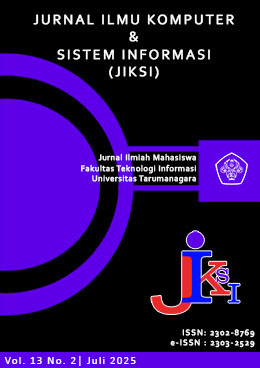Perancangan Dashboard Analitik Untuk Pemantauan Segmentasi Pelanggan Dengan K-Means Clustering
Main Article Content
Abstract
Pelanggan merupakan aspek penting yang menentukan keberlanjutan bisnis perusahaan. Dengan memahami perilaku dan nilai pelanggan, perusahaan dapat mengembangkan strategi pemasaran dan mempertahankan retensi pelanggan, serta menciptakan keunggulan dalam pasar. Penelitian ini bertujuan untuk melakukan analisis segmentasi pelanggan dan menyajikan hasil tersebut ke dalam bentuk dashboard. Analisis segmentasi pelanggan dilakukan menggunakan K-means clustering dengan fitur LRFM model dan nilai CLV. Berdasarkan hasil elbow method dan silhouette score, jumlah klaster optimal yang dipilih adalah k=6, sehingga terbentuk enam segmen pelanggan yang memiliki karakteristik unik. Hasil clustering kemudian digunakan untuk merancang dashboard yang berisi ringkasan karakteristik setiap segmen pelanggan, serta menyajikan informasi mengenai pola perilaku dan nilai CLV yang dihasilkan oleh pelanggan. Penelitian ini berhasil mengintegrasikan analisis clustering dalam segmentasi pelanggan serta merancang dashboard interaktif yang menyajikan informasi relevan sesuai dengan kebutuhan bisnis perusahaan XYZ, yaitu membantu tim marketing dalam memahami perilaku dan potensi nilai pelanggannya secara lebih dalam.
Article Details

This work is licensed under a Creative Commons Attribution-NonCommercial-ShareAlike 4.0 International License.
This work is licensed under a Jurnal Komunikasi Creative Commons Attribution-ShareAlike 4.0 International License.
References
[1] N. L. Rane, A. Achari and S. P. Choudhary, "Enhancing customer loyalty through quality of service: Effective strategies to improve customer satisfaction, experience, relationship, and engagement," International Research Journal of Modernization in Engineering Technology and Science, vol. 5, no. 5, pp. 427-452, 2023.
[2] N. I. Putri, R. Komalasari and Z. Munawar, "Pentingnya Keamanan Data dalam Intelijen Bisnis," J-SIKA| Jurnal Sistem Informasi Karya Anak Bangsa, vol. 1, no. 2, pp. 41-48, 2020.
[3] F. J. Reh, "Understanding Pareto's principle-the 80-20 rule," The Balance, vol. 8, 2017.
[4] Y. Sun, H. Liu and Y. Gao, "Research on customer lifetime value based on machine learning algorithms and customer relationship management analysis model," Heliyon, vol. 9, no. 2, 2023.
[5] R. A. Megantara, F. Alzami, A. Akrom, R. A. Pramunendar, D. P. Prabowo, S. Wibowo and R. , "RFM Analysis for CustomerLifetime Valuewith PARETO/NBD Model in Online Retail Dataset," Moneter: Jurnal Keuangan dan Perbankan, vol. 11, no. 2, pp. 284-290, 2023.
[6] F. Yoseph, N. H. Ahamed Hassain Malim, M. Heikkila, A. Brezulianu, O. Geman and N. A. Paskhal Rostam, "The impact of big data market segmentation using data mining and clustering techniques," Journal of Intelligent & Fuzzy Systems, vol. 38, no. 5, pp. 6159-6173, 2020.
[7] N. T. Lee, H. C. Lee, J. Hsin and S. H. Fang, "Prediction of customer behavior changing via a hybrid approach," IEEE Open Journal of the Computer Society, vol. 5, pp. 27-38, 2024.
[8] A. M. Haddadi and H. Hamidi, "A hybrid model for improving customer lifetime value prediction using stacking ensemble learning algorithm," Computers in Human Behavior Reports, vol. 18, 2025.
[9] R. P. Kuswidyawan, D. Trisnawarman and J. Hendryli, "Customer segmentation with K-means clustering algorithm for E-commerce sales visualization," AIP Conference Proceedings, vol. 2680, no. 1, 2023.
[10] R. Zimmermann and P. Brandtner, "From Data to Decisions: Optimizing Supply Chain Management with Machine Learning-Infused Dashboards.," Procedia Computer Science, vol. 237, pp. 955-964, 2024.
[11] F. Marisa, S. S. S. Ahmad, Z. I. M. Yusof, F. and T. M. A. Aziz, "Segmentation model of customer lifetime value in small and medium enterprise (SMEs) using K-means clustering and LRFM model," International Journal of Integrated Engineering, vol. 11, no. 3, pp. 169-180, 2019.
[12] M. Singh, "Predictive Analytics in Evaluating Customer Lifetime Value: A Paradigm Shift in Modern Marketing," International Journal of Science and Research (IJSR), vol. 12, no. 6, pp. 1771-1774, 2023.
[13] B. C. Laksono and I. Y. Wulansari, "Pemodelan Dan Penerapan Metode Rfm Pada Estimasi Nilai Konsumen (Customer Lifetime Value) Menggunakan K-Means Clustering Machine Learning," Seminar Nasional Official Statistics, vol. 2020, no. 1, pp. 1277-1285, 2020.
[14] T. M. Kodinariya and P. R. Makwana, "Review on determining number of Cluster in K-Means Clustering," International Journal, vol. 1, no. 6, pp. 90-95, 2013.
[15] V. A. Kherdekar and S. Naik, "Impact of Feature Normalization Techniques For Recognition of Speech for Mathematical Expression," in Smart Trends in Computing and Communications, Springer, 2024, pp. 109-117.
[16] A. Et-Taleby, M. Boussetta and M. Benslimane, "Faults Detection for Photovoltaic Field Based on K‐Means, Elbow, and Average Silhouette Techniques through the Segmentation of a Thermal Image," International Journal of Photoenergy, vol. 2020, no. 1, 2020.
[17] C. Yuan and H. Yang, "Research on K-value selection method of K-means clustering algorithm," J, vol. 2, no. 2, pp. 226-235, 2019.
[18] K. R. Shahapure and C. Nicholas, "Cluster quality analysis using silhouette score," 2020 IEEE 7th international conference on data science and advanced analytics (DSAA), pp. 747-748, 2020.
[19] E. Savran, E. Karpat and F. Karpat, "Energy-Efficient Anomaly Detection and Chaoticity in Electric Vehicle Driving Behavior," Sensors, vol. 24, no. 17, 2024.
[20] D. Bertsimas, A. Orfanoudaki and H. Wiberg, "Interpretable Clustering via Optimal Trees," arXiv preprint arXiv:1812.00539, 2018.
[21] L. A. García-Escudero, A. Gordaliza, C. Matrán and A. Mayo-Iscar, "A review of robust clustering methods," Advances in Data Analysis and Classification, vol. 4, pp. 89-109, 2010.



